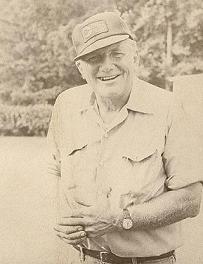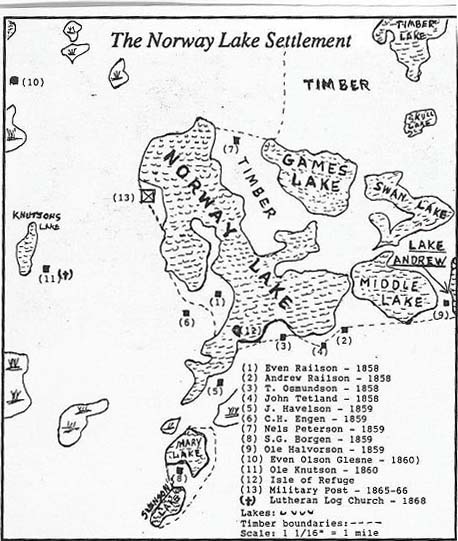Mankell Family History
"Gunder Swenson lived in interesting times"
written by Orlynn Mankell

Storyteller and historian, Orlynn Mankell
From West Central Tribune, February 5, 1986:
Sled dog driver Rick Swenson, who was featured in the Tribune recently, happens to have a certain background, or heritage, behind him that might be interesting to mention. It is probably only natural for Rick to do things like taking his dogs through a thousand miles of Alaskan wilderness during the running of the Iditarod. Rick is a great-grandson of noted Norway Lake pioneer Gunder Swenson....
Gunder Swenson was among those eight or so Norwegian families who had come to the Norway Lake region during that period of 1858-1860. And, as this early period would indicate, these were a brave and hardy people who would give root to Kandiyohi County's earliest permanent settlement. There, among the wilds of earliest Kandiyohi County, is where Gunder was growing up....
Probably no one in Kandiyohi County knew the American Indian as did Gunder Swenson -- or was on better terms with him. From one account: "He associated with them like ordinary white folks." Among them were young men of his own age. They taught Gunder how to count to 10 in their tongue and Gunder picked up other parts as well.
These people were referred to as Agency Indians and would come up past the cabin heading for the Norway Lake "Big Woods" while on their hunting trips -- or at time, it seems, just to be here. They would come up from their villages along the Minnesota River and, as they made these visits, it was actually a return to their homeland where, undoubtedly, many of them had been born. It was a land they knew thoroughly and intimately and which they had given up in the treaties of 1851.
Gunder would visit their camps, usually along a lake. Or he would run into them across the prairies, along woodland trails or around the cabin where Gunder's father, Swen Gunderson Borgen, did a certain amount of trading with them. In the fall of 1860, a large band, described as numbering about 400 with women and children and many horses, went through the settlement. Gunder also seems to have a certain life of adventure.
But Gunder's good relations with the Sioux would take a sudden and drastic turn. He was finding it difficult to believe when he first learned that the closely neighboring Swedish Colony at West Lake was now almost extinct after a sudden and savage Indian attack on this day of August 20, 1862....Gunder was about to make a notable trip. He was now 17 years old.
When it was determined that Norway Lake would have to be abandoned because of the hostilities and bloodshed which now included all of Kandiyohi County, Gunder was to figure prominently in the preparations. He was detailed for guard duty while the 14 West Lake victims were being buried. He helped load wagons with household goods. He helped gather the cattle from the settlement into one herd. These were eventful and turbulent days in the Norway Lake Colony -- and Gunder was getting much material to describe in later years.
It was a hard and exhausting trip for everyone as these early Kandiyohi County colonists headed east for St. Cloud. The column of horse and ox drawn wagons was fairly well protected, but there was this constant wearing sense of imminent danger.
Gunder would remember the difficulty in getting the cattle onto the Mississippi River ferry at St. Cloud as these uprooted and displaced Norwegians headed east for another 15 miles to the small community of St. Frances and along the river with the same name. Gunder was now a refugee from a war zone. Behind them at Norway Lake a couple of wheat fields still stood in shocks -- and would remain this way.
The St. Francis experience was something entirely different than what they had been used to. It was a frustrating and strange time of seeming to belong neither here nor there. Everyone thought they would be back home in a couple of months at most -- but in the end it was to be for over two years.
But life continued. Some of the men found work in the lumbering companies to the east, along the Rum River. Margit, Gunder's mother, continued to milk their two cows. Gunder spent time hunting, shooting at least one deer, and was a provider for the family food supply. Seventy miles to the west, at Norway Lake, the lake was back in its original wilderness setting -- the way it had lain for thousands of years.
A tedious winter came and left and the days were wearing on into the summer of 1863. There was still no word as to when they might return. Kandiyohi County had been sealed off by the state and off limits to white and Indian alike. Soldiers' patrols saw to it that this was so. Along the St. Frances, the inhabitants were reading accounts of the recent Civil War battle of Gettysburg....
Not only was Gunder among the very first to come to Kandiyohi County, he would also be about the very first to return following the exodus of 1862. In the summer of 1864, the military patrol lines were extended west and in so doing, the settlers were now free to return. And the very first to do so were Swen and Margit and their son Gunder doing so in the fall of 1864. The long exile was over.
Everything had changed. As far as it is known, Gunder never saw his colorful friends from the trail again. The Sioux Indian was gone and in his place was the soldier.
A part of the new patrol line was Outpost Norway Lake, situated on the west side of the lake. The appointed duties for the men at the post were to maintain the peace on the Kandiyohi County frontier, and for a year and a half Gunder would notice the mounted men from the post going by...In early 1866 the soldier, too, was gone.
In his later years, Gunder would recount the many incidents of his event-filled life, stories from the old Norway Lake Settlement. He was almost 90 when he died in 1934. In September of that year word came that the old pioneer, this son of Minnesota's early and wild frontiers, had died at his farm home on Lake Mary. Much of Minnesota would note his passing.

Map of Norway Lake Settlement, noting Borgen/Swenson cabin near Lake Mary and the military outpost.
The Mankell homestead is about 1.25 miles east of the Borgen/Swenson homestead (where the word "Borgen" is written on the map).
Source: Keeping the Faith...Sharing the Faith
Note from Carolyn Sowinski: The writer of this article was my father. Early settler Gunder Swenson was my great-great-grandfather.
Orlynn's articles about Kandiyohi County history:
- Why the Dakota loved Kandiyohi County
- Gunder Swenson, Norwegian Settler
- Thomas and Bergit Osmundson
- Pioneer Woman: Anne Christopherson Olson Holter
- Lonely Gravestone Tells of Pioneer's Fate: Johannes Iverson
- 1863 Drought in Kandiyohi County
- Norway Lake Pioneer (Sven Borgen) Endured Drought of 1863
- Threshing Machine
- Lake Florida Mission Church